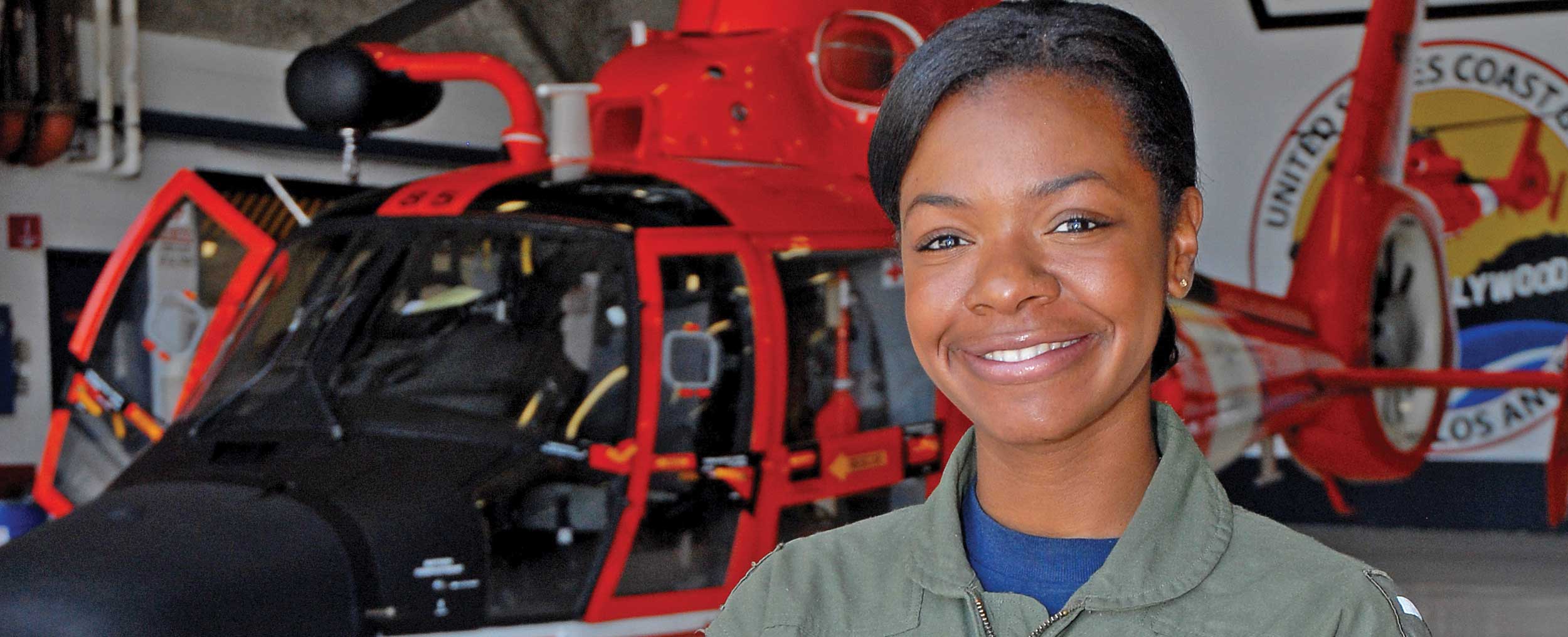 I Get Paid For This…
I Get Paid For This…
Rescuing sailors, intercepting drug traffickers and protecting the President – it’s all in a day’s work for the US Coast Guard’s first female African American helicopter pilot. Interview by Yayeri van Baarsen
How did you get into flying?
While serving on the Coast Guard cutter Midgett, aiming to become a shipmaster, I was asked if I’d ever considered aviation. I hadn’t, as I thought it required an engineering background. Hearing that there was only one African American woman flying in the USCG, Jeanine Menze, floored me.
I met Jeanine in Clearwater, Florida, where she took me up in a Lockheed C-130 Hercules and inspired me to get into aviation. In 2008 I got accepted into flight school, and in May 2010 I graduated as the Coast Guard’s first female, African American helicopter pilot.
Tell us about your job…
Every month I do five or six 24-hour duties. As with the fire service, you sleep at work and are the first responder when a call comes in. This can be anything from a boat that’s taken on water to intel about drugs or smuggled migrants, and from a missing sailor to someone who’s had a heart attack aboard a cruise ship. It’s different all the time, so you’re always on your toes.
Two years ago, I flew Rotary Wing Air Interception missions out of Washington Reagan. There’s a no-fly air zone around the President, and whenever somebody violates it, we intercept. You never know their intentions, so we arrive as quickly as possible. Normally, I do Law Enforcement and Search & Rescue missions.
Flying a helicopter is really cool – hovering is just magical! The best bit, though, is being able to help people. It’s a big ocean out there – occasionally you find someone floating in the water, only because the heli’s searchlight hits the reflectors on their life vest. Sometimes you see their face when hoisting them up, as they realise they’ve been rescued. Saving lives is the most rewarding feeling in the world.
What training did you have?
The Navy’s flight school, NAS Pensacola, Florida, were some of the best years of my life. It was challenging – my classmates were mostly white males who knew every single aircraft type and had wanted to be there all their lives, while I’d made a last-minute decision to enrol.
Policies and procedures are the same across the USCG, allowing me to get into a helicopter in any other base and launch immediately. The USGC has some of the best courses – pilots from all over the world come to Mobile, Alabama, for our simulators. The work’s difficult, you’re hovering 30ft over the ocean, sometimes 100 miles offshore, and the training reflects that. Every pilot here is always on their ‘A-game’.
What’s been your favourite flight?
A rescue mission in Los Angeles during 2013. I’d encountered some personal challenges so it took me longer than average to progress up to being aircraft commander. Two days after becoming the senior officer on duty, on a day when the fog had just started to clear, the alarm went off: an unconscious diver in a recreational vessel, 30 miles offshore. My heart started beating and my palms became sweaty.
We took off, rescued the woman and took her to hospital. I’ll always remember that flight, not just because we saved her life, but also because it was my first mission as aircraft commander. Only a few years before, I’d thought about giving up aviation… it was a confidence-builder which proved I belong here.
And your favourite airfield?
Atlantic City, New Jersey. The airport is OK, but what makes it really great are the many flights to New York and interception missions to Washington DC. Flying downtown New York, over Central Park and the Brooklyn Bridge, is stunning. In DC we fly very low, sometimes 100ft above ground, which makes it awesome. I once flew there on Independence Day (4 July) – with fireworks going off everywhere.
Do you get to fly much outside work?
No, the last time was when I was stationed in LA and volunteered at Compton/Woodley Airport, where we taught youngsters to fly Cessna 152s and 172s. I’d love to become an instructor pilot.
What’s the most valuable career advice you’ve received?
Be a lifelong learner. I try to take advantage of every single educational possibility. It’s important to keep up with what’s happening in the world, especially in the military, where we’re often so involved in our flying missions that we rarely take a break to look around us.
Flying CV
Lieutenant La’Shanda Holmes became the US Coast Guard’s first female, African American helicopter pilot in 2010 and flies an MH-65 Dolphin: “I love it. It’s become an extension of me.”
Started June 2010
Now flying Eurocopter MH-65 Dolphin
Favourite Eurocopter MH-65 Dolphin
Hours at job start Approx 230
Hours now Approx 1,600
